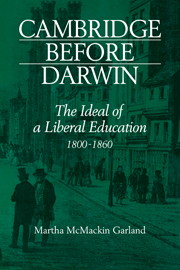Book contents
7 - The disintegration of an ideal
Published online by Cambridge University Press: 07 October 2011
Summary
Even while their academic disciplines were undergoing development and sometimes crisis, the dons of Cambridge managed to articulate a stable university ideal which they were determined to uphold: the ideal of a liberal education. Their concern to make orderly and then to vindicate their educational program grew at least in part out of their ‘Victorian’ morality – it was their duty, enforced by their oaths, to make the University genuinely into a ‘seminary of sound learning and religious education’. Unlike their eighteenth-century counterparts, they took their duty seriously. Furthermore, interest in educational theory was fashionable. Thinkers outside the Cambridge community – J. S. Mill, T. H. Huxley, John Henry Newman, Edward Pusey, and Mark Pattison – also wrote treatises on the subject during the middle part of the century. Another reason why the concept of a liberal education was so appealing at Cambridge was that it meshed neatly with the other intellectual principles which the university dons held dear. It was the pedagogical expression of their commitment to a unitary world of truth.
Their educational program had several components, the most obvious being the curriculum. The principles on which a liberal curriculum should be based were clearly spelled out in Whewell's educational treatises and in Sedgwick's Discourse on the Studies of the University. Because mathematics develops the reasoning power and ancient literature heightens taste and connects men with all the best wisdom of the past:
The study of elementary mathematics … along with the study of classical authors, ought to be imperatively required by all Universities. […]
- Type
- Chapter
- Information
- Cambridge Before DarwinThe Ideal of a Liberal Education, 1800–1860, pp. 113 - 135Publisher: Cambridge University PressPrint publication year: 1980



